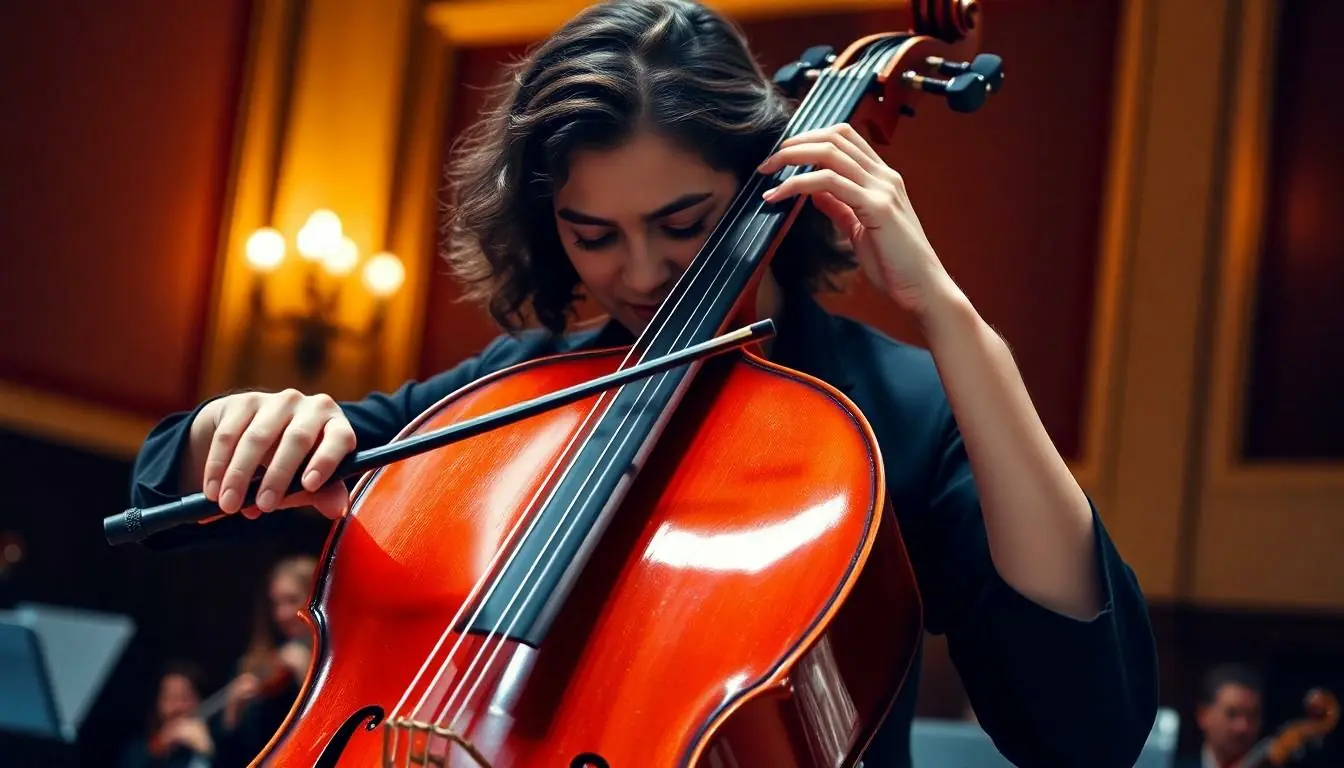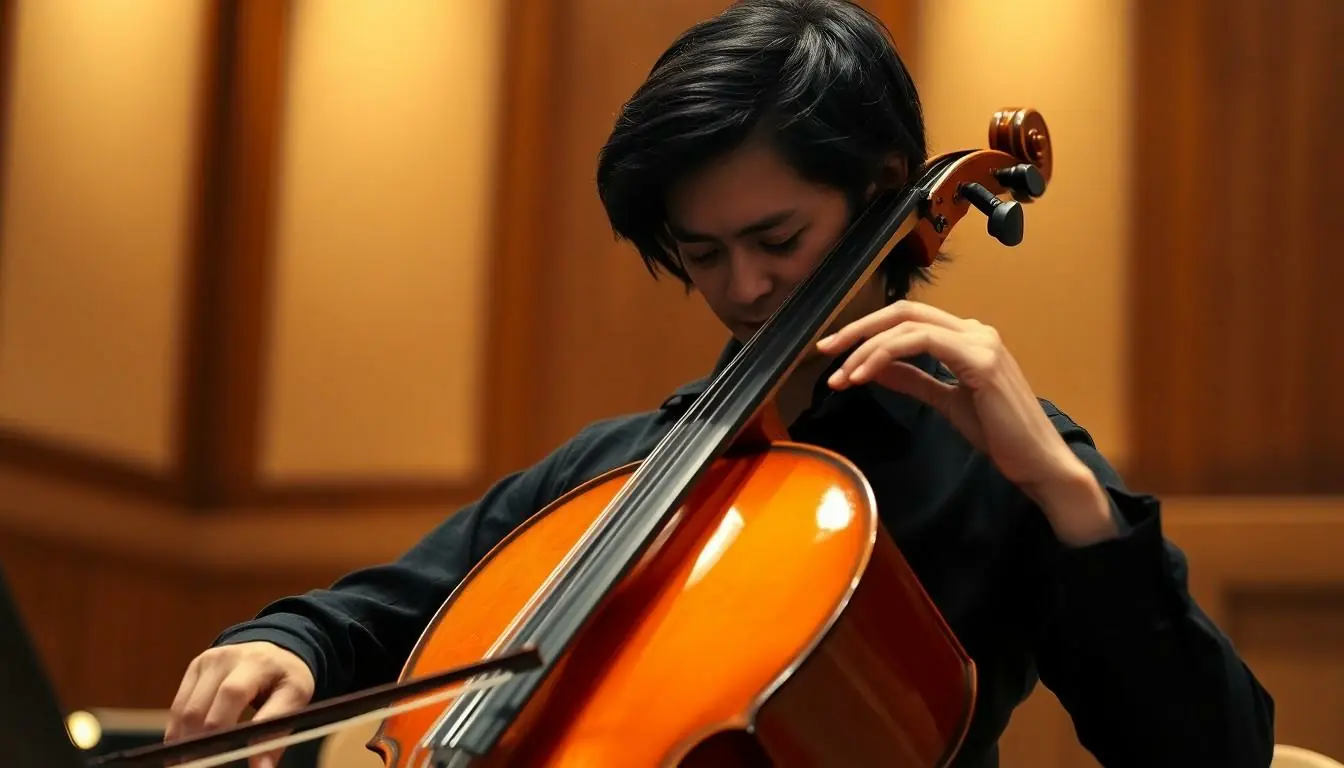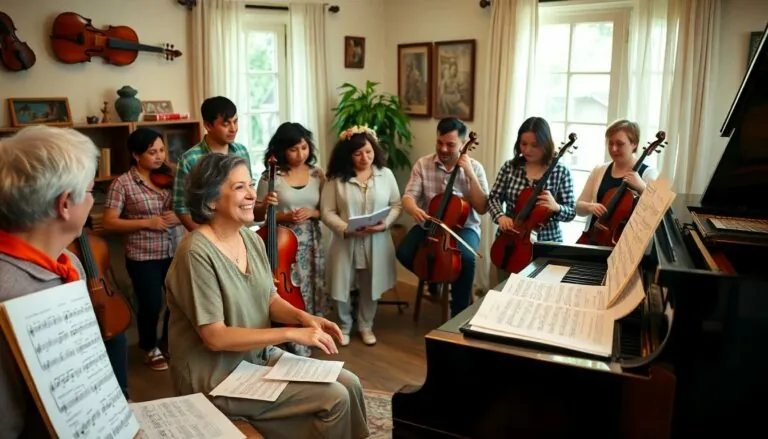Table of Contents
ToggleImagine a world where the rich, velvety tones of the cello sweep you off your feet, leaving you entranced and slightly questioning your life choices. Classical cello music isn’t just for stuffy concert halls; it’s a delightful escape that can transform any mundane moment into a dramatic scene worthy of a movie soundtrack.
With its deep resonance and expressive capabilities, the cello has a unique way of tugging at the heartstrings—sometimes literally. Whether it’s the melancholic strains of a Bach suite or the lively rhythms of a Vivaldi concerto, there’s a cello piece ready to match every mood. So grab your favorite snack, settle in, and let the soothing sounds of classical cello music whisk you away on an unforgettable auditory journey.
Overview of Classical Cello Music
Classical cello music represents a rich tradition within the broader classical music genre. It showcases the cello’s unique qualities, such as its deep timbre and range. The instrument often evokes powerful emotions, allowing listeners to connect on a deeper level.
Composers like Johann Sebastian Bach profoundly influenced the cello repertoire. His six cello suites feature intricate melodies and complex harmonies, making them staples for cellists and audiences. In addition, Antonio Vivaldi’s concertos highlight the cello’s agility, blending lively rhythms with expressive lines.
Pieces span various styles and eras, offering a diverse listening experience. Romantic composers such as Johannes Brahms and Edward Elgar contributed beautiful sonatas that explore the instrument’s emotional depth. Contemporary works continue to push boundaries, incorporating innovative techniques that expand the cello’s sonic palette.
Performances often bring these compositions to life through skilled interpretations. Numerous cellists, such as Yo-Yo Ma and Mischa Maisky, captivate audiences with their technical precision and emotional storytelling. These artists emphasize the cello’s versatility in solo and ensemble settings.
Beyond concert halls, classical cello music enhances everyday moments. Its soothing qualities make it a popular choice for meditation, relaxation, and background music. Many listeners find comfort in the instrument’s warm sound, creating a sense of calm in a hectic world.
Engaging with classical cello music provides an enriching experience, deepening appreciation for this magnificent instrument. Discoveries await those willing to explore its storied past and vibrant present.
Notable Composers and Works

Classical cello music features the contributions of many influential composers. Their works showcase the cello’s richness and versatility across centuries.
Johann Sebastian Bach
Bach’s six cello suites stand as monumental achievements in classical music. These compositions, characterized by their intricate counterpoint, highlight the cello’s expressive range. Each suite consists of a prelude followed by a set of dance movements, allowing performers to explore both technical skill and emotional depth. The Prelude from Suite No. 1 in G major remains especially popular, often celebrated for its lyrical beauty. Through these works, Bach established a foundation for future cello repertoire, inspiring generations of musicians.
Ludwig van Beethoven
Beethoven’s contributions to cello literature include five sonatas and a concerto that display his innovative spirit. The Cello Sonata No. 3 in A major is notable for its lyrical lines and conversational interplay between cello and piano. His Cello Concerto in B-flat major showcases the instrument’s power while capturing an array of emotions. Alongside deep expressiveness, Beethoven’s works present technical challenges that elevate a cellist’s artistry. These compositions continue to be central to the concert repertoire, reflecting the evolution of cello music during the transitional Classical to Romantic period.
Camille Saint-Saëns
Saint-Saëns significantly influenced cello music with his Cello Concerto No. 1 in A minor, written in 1872. This piece presents a seamless blend of technical demands and lyrical themes, making it a favorite among cellists. Unique structural elements, such as its single-movement design, showcase the instrument’s capability for dramatic expression. Additionally, Saint-Saëns’ other works, including the “The Swan” from “Carnival of the Animals,” highlight his melodic sensibility and affinity for the cello’s voice. His compositions remain staples of the cello repertoire, emphasizing both beauty and technical prowess.
Techniques and Styles
In classical cello music, various techniques and styles enhance the instrument’s emotive power and technical prowess. These methods allow performers to express a wide range of musical ideas.
Bowing Techniques
Bowing techniques significantly impact the cello’s sound production. Each technique offers distinct tonal qualities and articulations. For example, legato bowing creates a smooth, connected sound, while staccato playing produces short, sharp notes. Spiccato, a bouncing bow technique, delivers a light texture, often suited for lively pieces. Additionally, col legno involves striking the strings with the bow’s wood, producing a unique percussive effect. Mastering these techniques allows musicians to interpret compositions with depth and nuance.
Pizzicato and Other Techniques
Pizzicato refers to plucking the strings with fingers, offering a contrasting sound to bowing. This method is common in fast sections or to create rhythmic interest. Other techniques include harmonics, which involve lightly touching the string at specific points to produce ethereal tones. Sul ponticello creates an eerie sound by bowing near the bridge. Each of these techniques enriches the performance, showcasing versatility. By exploring these innovative styles, cellists expand their interpretative possibilities and connect more profoundly with audiences.
The Role of the Cello in Orchestras
Cellos play a vital role in orchestras, contributing rich textures and depth. The instrument’s deep tones provide harmonic support for violins and violas, enhancing the overall sound. In a typical orchestral setting, cellists often perform in pairs or sections, creating a warm, resonant foundation for the ensemble.
Sections of the cello frequently alternate articulations with the violas, establishing a dialogue that enhances musical narratives. Cellos frequently take the lead in themes, showcasing their expressive capabilities. Compositions, such as Dvořák’s Cello Concerto and Tchaikovsky’s Variations on a Rococo Theme, highlight the cello’s melodic potential within orchestral pieces.
When accompanying orchestral works, cellists employ a variety of techniques to maintain performance balance. Their ability to produce strong legato lines contributes to seamless musical transitions. Additionally, skilled cellists utilize a mix of dynamics, allowing for poignant soft passages and powerful climaxes.
Collaborative efforts among cellists also enhance orchestral performance. Cellos often participate in chamber music settings, where they work closely with other string players. This collaboration allows for deeper exploration of musical ideas, further enriching the orchestral experience.
Educational institutions emphasize the importance of cello sections in youth orchestras. Students learn the significance of cohesion and teamwork, fostering a sense of community through shared musical endeavors. Building strong relationships among musicians contributes to engaging performances that resonate with audiences.
Cellists embody the heartbeat of orchestras. Their contributions amplify the emotional weight and complexity of performances, allowing orchestras to convey a wide range of musical expressions. Through their essential role, cellists enhance the richness of classical music, connecting with listeners across various settings.
Modern Interpretations of Classical Cello Music
Modern interpretations of classical cello music bring fresh perspectives to timeless compositions. Contemporary cellists explore innovative techniques and styles, revitalizing traditional pieces while respecting their historical contexts. They blend genres such as jazz, folk, and pop, creating unique arrangements that attract diverse audiences. Notable cellists like Yo-Yo Ma often collaborate with artists from different musical backgrounds, showcasing the cello’s versatility.
New compositions also emerge, reflecting current themes and emotions. Composers like David Popper and Esa-Pekka Salonen write pieces that push the boundaries of cello performance. Innovative works incorporate extended techniques, challenging cellists to expand their expressive range. Such creativity breathes new life into the cello repertoire, appealing to both seasoned listeners and newcomers.
Performance practices evolve, too. Cellists may use electronic effects, enhancing soundscapes and adding layers of texture. This blending of acoustic and electronic elements transforms the listening experience, making it more immersive. Moreover, improvisation gains prominence in modern performances, inviting spontaneity into traditional settings.
Cellists also engage in various collaborative projects. Cross-genre collaborations lead to unexpected fusions that resonate with wider audiences. Festivals dedicated to contemporary cello music feature a mix of established and emerging artists, encouraging exploration and experimentation.
These modern interpretations not only honor classical foundations but also forge new paths. They connect with younger generations, fostering interest in the instrument and its capabilities. As the cello continues to evolve, it remains a powerful vehicle for emotional expression, weaving its rich history into today’s musical landscape.
Classical cello music stands as a timeless bridge between the past and the present. Its rich history and emotional depth continue to resonate with audiences across generations. The instrument’s versatility allows it to transcend traditional boundaries, inviting fresh interpretations and collaborations that enrich the musical landscape.
As contemporary cellists experiment with new techniques and genres, they breathe life into classical compositions while honoring their roots. This evolving art form not only captivates seasoned listeners but also engages a new audience eager to explore the cello’s expressive potential. Embracing classical cello music offers a unique journey filled with beauty and inspiration.






